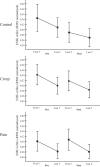Motor adaptations to trunk perturbation: effects of experimental back pain and spinal tissue creep
- PMID: 29975166
- PMCID: PMC6230797
- DOI: 10.1152/jn.00207.2018
Motor adaptations to trunk perturbation: effects of experimental back pain and spinal tissue creep
Abstract
In complex anatomical systems, such as the trunk, motor control theories suggest that many motor solutions can be implemented to achieve a similar goal. Although reflex mechanisms act as a stabilizer of the spine, how the central nervous system uses trunk redundancy to adapt neuromuscular responses under the influence of external perturbations, such as experimental pain or spinal tissue creep, is still unclear. The aim of this study was to identify and characterize trunk neuromuscular adaptations in response to unexpected trunk perturbations under the influence of spinal tissue creep and experimental back pain. Healthy participants experienced a repetition of sudden external trunk perturbations in two protocols: 1) 15 perturbations before and after a spinal tissue creep protocol and 2) 15 perturbations with and without experimental back pain. Trunk neuromuscular adaptations were measured by using high-density electromyography to record erector spinae muscle activity recruitment patterns and a motion analysis system. Muscle activity reflex attenuation was found across unexpected trunk perturbation trials under the influence of creep and pain. A similar area of muscle activity distribution was observed with or without back pain as well as before and after creep. No change of trunk kinematics was observed. We conclude that although under normal circumstances muscle activity adaptation occurs throughout the same perturbations, a reset of the adaptation process is present when experiencing a new perturbation such as experimental pain or creep. However, participants are still able to attenuate reflex responses under these conditions by using variable recruitment patterns of back muscles. NEW & NOTEWORTHY The present study characterizes, for the first time, trunk motor adaptations with high-density surface electromyography when the spinal system is challenged by a series of unexpected perturbations. We propose that the central nervous system is able to adapt neuromuscular responses by using a variable recruitment pattern of back muscles to maximize the motor performance, even under the influence of pain or when the passive structures of the spine are altered.
Keywords: HD-EMG; creep; lumbar muscle; pain; spinal stability.
Figures
Similar articles
-
Superficial lumbar muscle recruitment strategies to control the trunk with delayed-onset muscle soreness.Eur J Appl Physiol. 2021 Sep;121(9):2573-2583. doi: 10.1007/s00421-021-04732-2. Epub 2021 Jun 6. Eur J Appl Physiol. 2021. PMID: 34095975
-
Effects of Muscle Fatigue, Creep, and Musculoskeletal Pain on Neuromuscular Responses to Unexpected Perturbation of the Trunk: A Systematic Review.Front Hum Neurosci. 2017 Jan 4;10:667. doi: 10.3389/fnhum.2016.00667. eCollection 2016. Front Hum Neurosci. 2017. PMID: 28101013 Free PMC article. Review.
-
Influence of Lumbar Muscle Fatigue on Trunk Adaptations during Sudden External Perturbations.Front Hum Neurosci. 2016 Nov 14;10:576. doi: 10.3389/fnhum.2016.00576. eCollection 2016. Front Hum Neurosci. 2016. PMID: 27895569 Free PMC article.
-
Effects of sudden walking perturbations on neuromuscular reflex activity and three-dimensional motion of the trunk in healthy controls and back pain symptomatic subjects.PLoS One. 2017 Mar 20;12(3):e0174034. doi: 10.1371/journal.pone.0174034. eCollection 2017. PLoS One. 2017. PMID: 28319133 Free PMC article.
-
Contributions to the understanding of gait control.Dan Med J. 2014 Apr;61(4):B4823. Dan Med J. 2014. PMID: 24814597 Review.
Cited by
-
Clinical utility and reproducibility of surface electromyography in individuals with chronic low back pain: a protocol for a systematic review and meta-analysis.BMJ Open. 2022 May 16;12(5):e058652. doi: 10.1136/bmjopen-2021-058652. BMJ Open. 2022. PMID: 35577472 Free PMC article.
-
Home-based arm cycling exercise improves trunk control in persons with incomplete spinal cord injury: an observational study.Sci Rep. 2023 Dec 13;13(1):22120. doi: 10.1038/s41598-023-49053-w. Sci Rep. 2023. PMID: 38092831 Free PMC article.
-
Low Back Pain: The Potential Contribution of Supraspinal Motor Control and Proprioception.Neuroscientist. 2019 Dec;25(6):583-596. doi: 10.1177/1073858418809074. Epub 2018 Nov 2. Neuroscientist. 2019. PMID: 30387689 Free PMC article. Review.
-
Increased Muscle Activity Accompanying With Decreased Complexity as Spasticity Appears: High-Density EMG-Based Case Studies on Stroke Patients.Front Bioeng Biotechnol. 2020 Nov 16;8:589321. doi: 10.3389/fbioe.2020.589321. eCollection 2020. Front Bioeng Biotechnol. 2020. PMID: 33313042 Free PMC article.
-
Superficial lumbar muscle recruitment strategies to control the trunk with delayed-onset muscle soreness.Eur J Appl Physiol. 2021 Sep;121(9):2573-2583. doi: 10.1007/s00421-021-04732-2. Epub 2021 Jun 6. Eur J Appl Physiol. 2021. PMID: 34095975
References
Publication types
MeSH terms
LinkOut - more resources
Full Text Sources
Other Literature Sources
Medical




